All Screwed Up

ALL SCREWED UP
What happens if you are sailing around the world and your propeller gets all screwed up?
You get it fixed…right?
Well, we are going to visit one such artisan who specializes in fixing screwed up propellers. But, before we do, let’s go back a while, say about a bit over two thousand years (to 220BC) and visit the thinking of a Greek named Archimedes. His world was very different then but Archimedes came up with the idea of using a screw to lift water for irrigation and bailing boats. It became so famous that it became known as Archimedes screw.
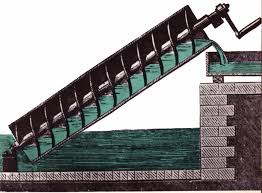
Years later Leonardo de Vinci (1452-1519AD) sketched the use of the screw idea for his submarine.
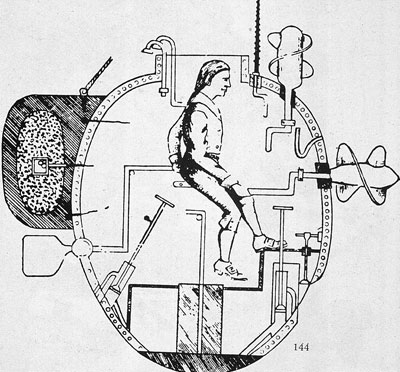
So who would have thought that Archimedes’ little sketch and Leonardo’s creative ideas would form the basis for titanic size ships propellers:
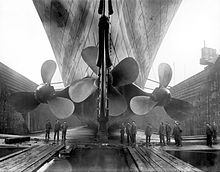
This shows Titanic’s three propellers. See the size of the people!
What is a propeller? A simple description is that a propeller is a type of fan that transmits power by converting rotational motion into thrust. A pressure difference is produced between the forward and rear surfaces of the airfoil shaped blade and fluid is accelerated behind the blade.
Three hundred years ago Bernoulli’s principle explained how pressure differences are created:

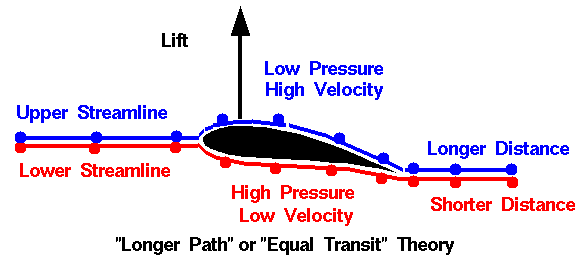
Bernoulli’s Principle:
“An increase in the velocity of any fluid is always accompanied by a decrease in pressure”
Thus, when fluid travels further around the curved side of a
propeller blade it has to travel faster (which means lower pressure) than the
fluid on the side with a shorter distance to travel.
The basic concept of an object being pulled toward low pressure is used in airplane propellers for lift and is even responsible for a sailboat’s sail
But a propeller in water is even more complicated and Newton’s Third Law comes in to play.
You remember this one: “For every action, there is an equal and opposite reaction.” So, as best as I can describe it, once the water reaches the propeller it enters the angled blades and the blades create a force on the water that is more or less at right angles to the blade. This force pushes the water backwards and makes it move in circles. As a result, the water that leaves the blades is moving axially and rotating about the axis. This means that the water has kinetic energy that it did not have initially and this energy has been imparted to the water by the propeller. If you think that designing the correct propeller for different boats is simple, I invite you to spend a few minutes reading up on Newton’s theory. Then call and explain it to me because I already tried to understand it and am a bit flummoxed.
Anyway, the hero of our propeller story, Chris, has been repairing propellers and propeller shafts for 34 years in Trinidad. Now, at the age of 78, he says that he is beginning to “think about retirement.”

The small wording on the sign says; “The difficult we do every day, the impossible takes a little longer”
During the past 34 years, Chris has repaired just about
every type of propeller from those on large Trinidadian oil tenders to
sailboats.
Chris mentions that there are three types of propellers that come to his shop.
1) Nickel/Aluminum/Bronze – This material is quite durable with a tensile strength up to 95,000 lbs per square inch. These propellers are used on boats with high horsepower and high r.p.m’s (revolutions per minute). These propellers are expensive.
2) Manganese/ Bronze – This material has good corrosion resistance, a tensile strength up to 65,000 lbs per square inch and are reasonably priced.
3) All aluminum – This material has a tensile strength of 40,000 lbs per square inch and is inexpensive. This is the most popular material for outboard engine propellers.
Note: There are also propellers made of stainless steel, plastics and composite materials but these do not come in for repair frequently to Chris’ shop.
Now the problem with propellers is that they hit hard objects in the sea, they get cables wrapped around them and they go aground; sometimes with dramatic effect.
Here is a picture of a propeller that has recently come to Chris’s shop. You can see that each blade is bent and one blade snapped off.

Believe it or not, this propeller will exit Chris’s shop looking brand new but first they need to be repaired.
Often the metal is in poor shape and needs to be re-welded or replaced with new metal.
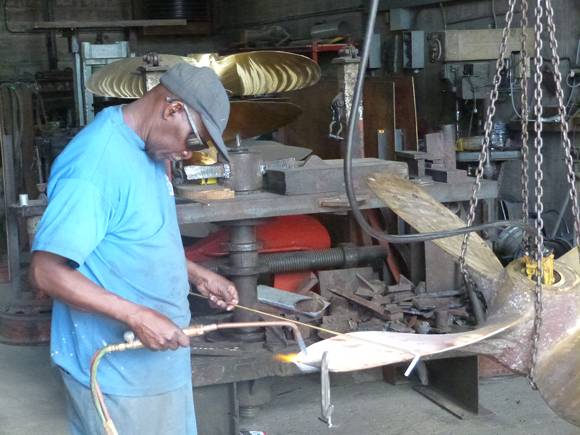
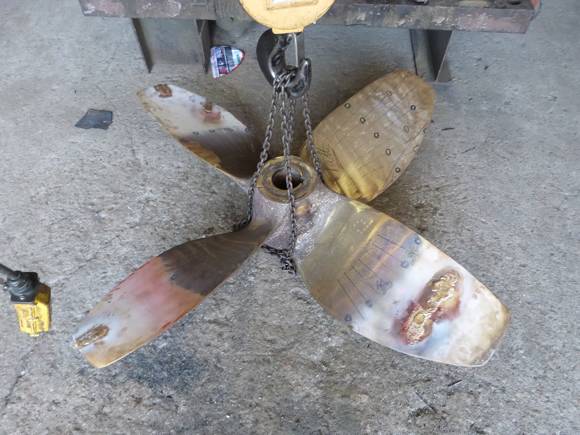
Then the artwork
begins, as Chris’s highly trained staff begins the task of ensuring that the
blades are all exactly shaped the same and have the same pitch (angle). Any difference in these critical dimensions
will cause violent shaking when revolutions increase to thousands of times per
minute.
You will notice, if you look at a propeller, that the pitch (angle) is different near the hub than at the end of the blades. The reason for a propeller’s contorted shape, as opposed to a relatively straight angle, is because the propeller is moving in a circular motion and the further you move out along the blade the faster that slice of the blade is moving. Therefore, the fast moving ends of a propeller need less pitch than the slower moving portion near the hub. Confused yet?
Chris and his team have to measure the blade, in many places, to ensure that the pitch is correct. All these little measurements must be exactly duplicated on all blades.
Each blade is therefore examined with great care and marked carefully using a “pitchometer” which is calibrated to measure angles on each blade at different places. Various measurements and devices are used to ensure that the all the blades come out equal.

Tracings are used to ensure that the edges of the blades are uniform, smooth and equal.
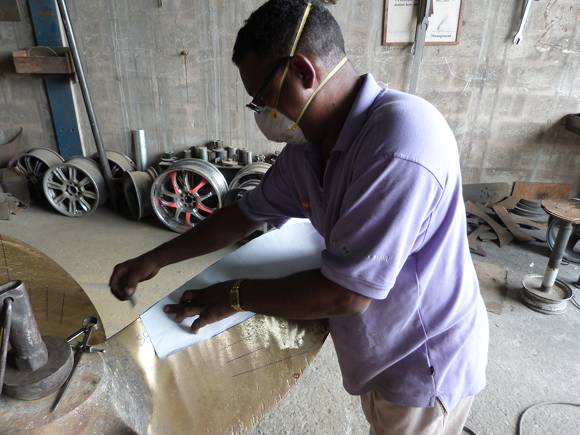
When the metal needs to be bent into specification, Chris uses one of several hydraulic presses. This big one below can bend propeller shafts to within thousands of an inch using 75 tons of pressure. Other smaller hydraulic presses are used for the propeller blades.
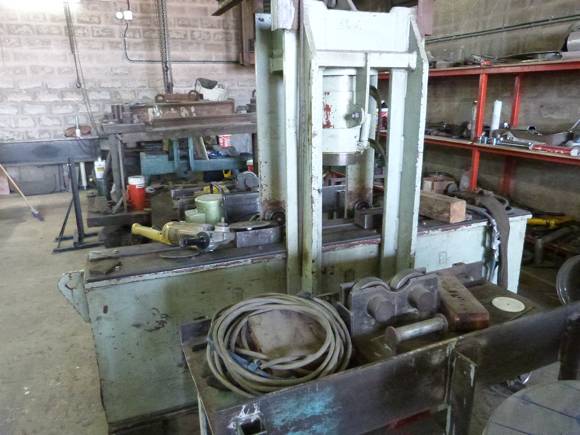
And, like every mechanic shop around the world, there is the requisite “pin-up” girl calendar.

There is also the standard “disclai
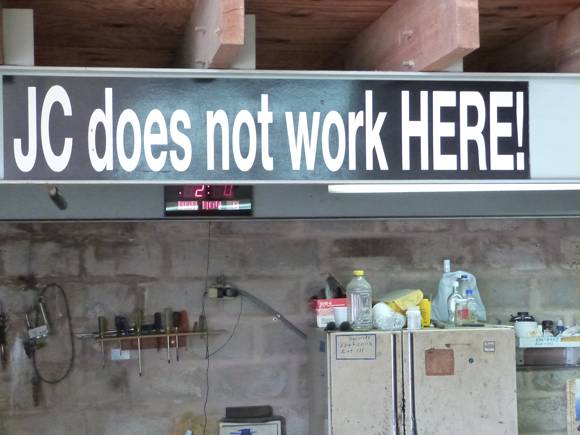
But , at the end of the day, the work is done to perfection and the propeller is given its final shine.
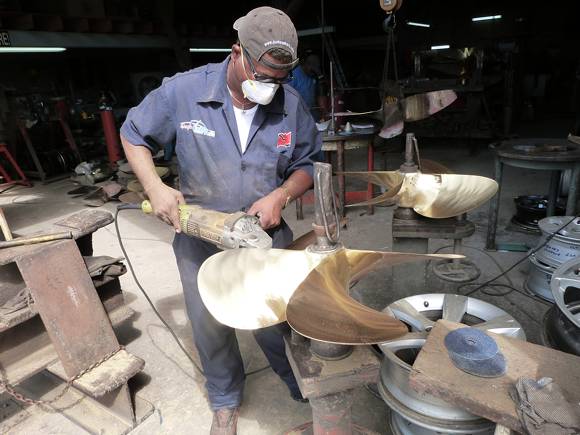
Chris says his reward is when the client - who had dropped off a bent, broken or barnacle encrusted propeller - looks at the final product with incredulous eyes and says, “Is this really my propeller?”
--
--
--